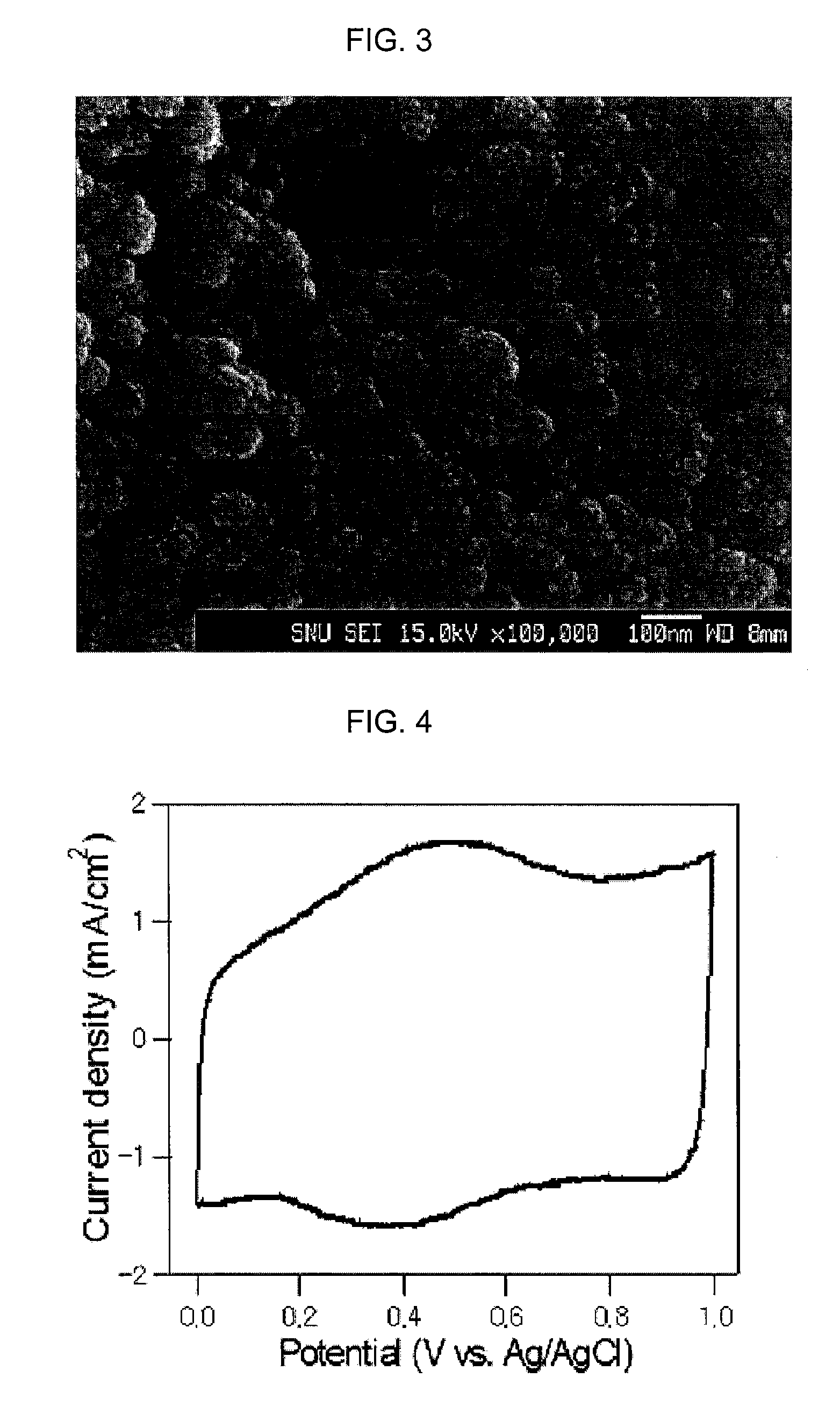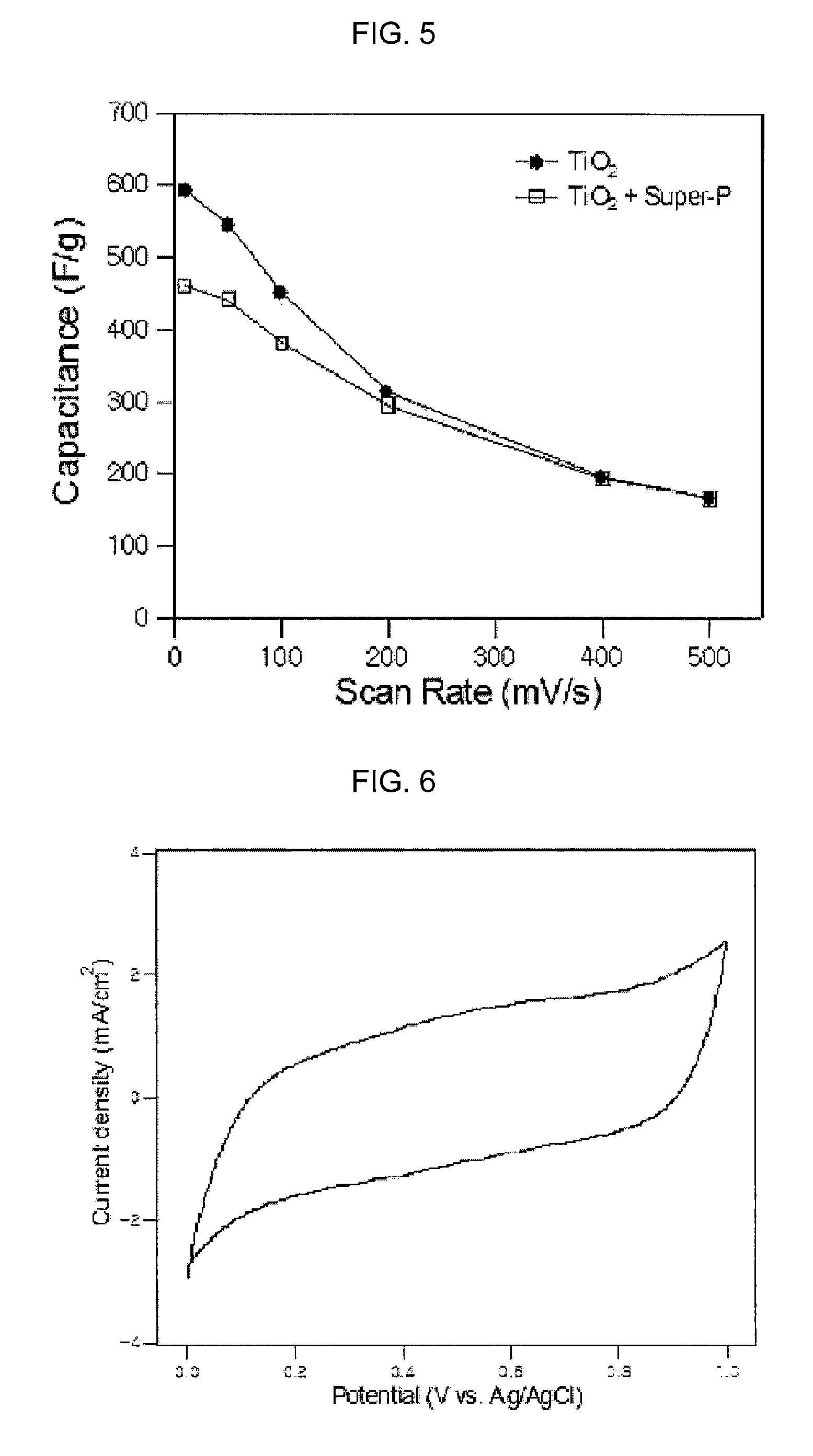Metal oxide supercapacitor having metal oxide electrode coated onto titanium dioxide ultrafine fiber and method for preparing the same
a technology of titanium dioxide and supercapacitor, which is applied in the direction of surface reaction electrolytic coating, solid-state diffusion coating, electrochemical machining apparatus, etc., can solve the problems of reduced function, low power density per unit weight, and difficulty in maintaining an excellent degree of carbon material dispersion
- Summary
- Abstract
- Description
- Claims
- Application Information
AI Technical Summary
Problems solved by technology
Method used
Image
Examples
embodiment 1
Preferred Embodiment 1
[0036] Ultrafine titanium oxide fibers prepared by electro-spinning a precursor solution on a current collector of a titanium metal plate and then sintering the solution has been used as a substrate. The substrate has an area of 1 cm×1 cm. 1.037 g of trichlororuthenium and 0.745 g of potassium chloride were dissolved in deionized water, thereby obtaining 100 ml of solution. The solution was maintained at 50° C. under a constant magnetic stirring, and the titanium oxide substrate was immersed into the solution for 20 minutes. Then, 5 mA of current was applied to the solution to deposit ruthenium oxides. Next, the ruthenium oxide was washed using deionized water. A weight difference between an electrode prior to deposition and an electrode after the deposition was used as the weight of the ruthenium oxide. A cyclic voltammetric graph was obtained from 0.5 m of aqueous solution sulfate. In the cyclic voltammetric graph, an average current was obtained and the aver...
embodiment 2
Preferred Embodiment 2
[0042]FIG. 8 shows a SEM photograph of an electrode in which an ultrafine titanium oxide fiber substrate (1 cm×1 cm) is deposited in 0.05 mmol of ruthenium chloride aqueous solution by a cyclic voltammetric method. Referring to FIG. 8, a period of 0.25˜1.45 V of a saturated Ag / AgCl electrode was circulated 600 times with a spinning rate of 300 mV / sec.
[0043]FIG. 9 shows a test result obtained by circulating a saturated Ag / AgCl electrode of a period of 0˜1V in 0.5 mmol of aqueous solution sulfate with a spinning rate of 10 mV / sec by a cyclic voltammetric method. As shown in FIG. 9, 473 F / g of specific capacitance was obtained.
embodiment 3
Preferred Embodiment 3
[0044]FIG. 10 shows a graph showing a cyclic voltammetric of an electrode heat treated according to each temperature. An electrode that has been deposited 50 times with a scanning rate of 50 mA / sec by a scanning potential current method was used. The specific capacitance was the greatest at a temperature of 175° C. as 594 F / g but was decreased at a temperature of 200° C. The reason is that a proton conductivity is decreased even if an electric conductivity is increased when a thermal processing temperature is increased.
PUM
| Property | Measurement | Unit |
|---|---|---|
| diameter | aaaaa | aaaaa |
| length | aaaaa | aaaaa |
| diameter | aaaaa | aaaaa |
Abstract
Description
Claims
Application Information
 Login to View More
Login to View More - R&D
- Intellectual Property
- Life Sciences
- Materials
- Tech Scout
- Unparalleled Data Quality
- Higher Quality Content
- 60% Fewer Hallucinations
Browse by: Latest US Patents, China's latest patents, Technical Efficacy Thesaurus, Application Domain, Technology Topic, Popular Technical Reports.
© 2025 PatSnap. All rights reserved.Legal|Privacy policy|Modern Slavery Act Transparency Statement|Sitemap|About US| Contact US: help@patsnap.com



